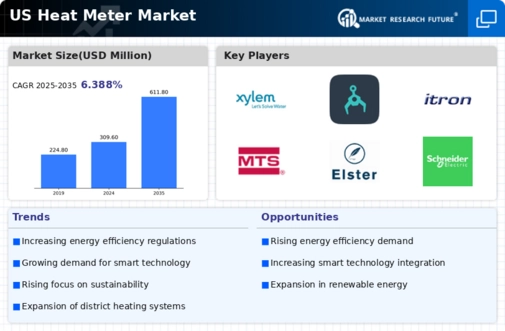The US Heat Meter Market has seen significant developments and competitive dynamics in recent years, driven by increasing energy efficiency regulations and the growing need for smart metering solutions. As the demand for accurate and efficient measurement of heating energy in residential and commercial buildings expands, several key players have emerged to dominate this sector. Companies are investing in innovative technologies to enhance their product offerings and improve the functionality of their heat meters. The competitive landscape is characterized by a mix of established enterprises and new entrants, all striving to capture market share and respond to evolving consumer needs.
Factors such as technological advancements, strategic partnerships, and customer service capabilities play essential roles in shaping the competition in this market.Sensus is a prominent player in the US Heat Meter Market, recognized for its strong presence and extensive distribution networks. The company has built a reputation for providing advanced heat metering solutions characterized by accuracy, reliability, and ease of integration with existing systems. Sensus stands out due to its commitment to innovation, continuously enhancing its offerings with cutting-edge technology and advanced analytics.
This focus on improving energy management solutions has enabled Sensus to be particularly successful in catering to utilities and large-scale energy consumers.
Furthermore, the strong brand equity and established relationships within the utility sector position Sensus well for ongoing growth in the competitive landscape of the US heat meter market.Axioma has also carved a niche for itself in the US Heat Meter Market, known for its comprehensive range of products and services designed to assist in energy measurement and management. The company focuses on providing state-of-the-art heat meters that align with the latest industry standards, ensuring compatibility and efficiency for customers.
Axioma's strengths lie in its ability to tailor solutions to meet specific client needs, underpinned by robust customer support and technical expertise. The company has explored strategic mergers and acquisitions to bolster its market presence, enhancing its product portfolio and expanding its reach within the US market. By continually innovating and refining its offerings, Axioma is positioning itself as a formidable competitor in the rapidly evolving heat metering space in the United States, responding proactively to the dynamic demands of the energy sector.






















Leave a Comment